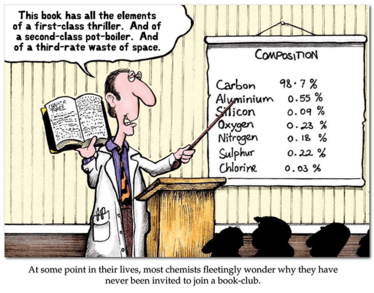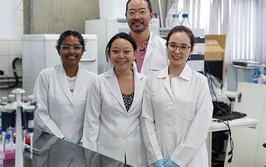The Analytical Cartoonist
Nick Kim is an analytical environmental chemist by day and analytical artist by night. What makes him tick?
How did you get into cartooning?
I think that when I started cartooning as a hobby, I was mainly pursuing two drivers: first, the intrinsic value of irreverence, and, second, the idea that we should be able to pursue humor for its own sake. Of course, in depth analysis like this may kill all future cartoon output!
Care to elaborate on that?
The first driver is about questioning the norms. I’m an “analytical type” and was one of those 1970s kids who identified with both M*A*S*H and Monty Python. In fact, irreverence for the established order could also be seen as a central modus operandi of science. Perhaps that explains why I gravitated towards a science career.
And the second driver?
I think the second driver is a consequence of the first. In New Zealand, we are subjected to a steady diet of editorial cartoons in our newspapers; the sort that aim to club readers over the head with an obvious message. I like some of those cartoons, but for the most part, I don’t enjoy such manipulation. I identify more strongly with cartoons that are funny or surreal, or that lift you out of your frame of reference. I especially love the work of the UK cartoonist Martin Honeysett, and US cartoonist Bernard Kliban.

Is there also an element of balancing the somewhat serious nature of your career?
I guess some of the work I've been involved in over the years could come across as being sober and serious – and, now that I think about it, a lot of it was. Perhaps I’ve been using cartoons as some sort of an antidote to the serious stuff. However, I also find it fascinating how we use analytical instruments to extend the power and range of our senses, and how far we’re gone with that approach in every branch of science from astrophysics to zoology. Of course, that theme goes back centuries, but the last one has been remarkable; just think of the progression that’s occurred since J. J. Thomson invented the first mass spectrometer in 1919.
You seem able to throw an analytical spotlight on people, things, approaches.
Environmental chemists (like me) and allied types often develop an extra dimension to their view of the physical world. A side effect of the analytical revolution is that a certain weird bunch of people (myself happily included) are able to see everyone and everything in terms of underlying chemical constituents and processes. Essentially, we can view every physical thing simply as a dynamic variation of the periodic table.
I do know that when I’m deprived of the ability to test for something, it’s a bit like I've lost a sense or had a limb truncated. You can see the same effect in a teenager if you manage to separate it from its cell phone.
For more irreverence, keep an eye on Upfront or visit www.scienceandink.com

















